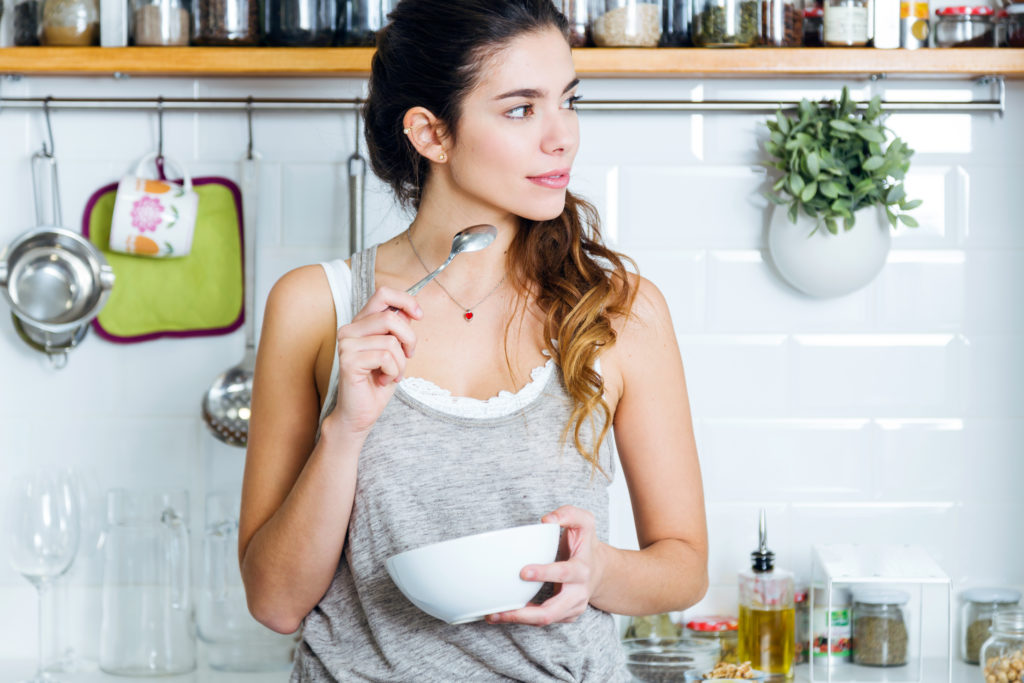“What’s for dinner?” is not a simple question anymore.
Everywhere you look, there’s a breaking news headline about what you should and shouldn’t eat. The conflicting advice can be overwhelming, leaving you scratching your head when you open the fridge.
Well, have no fear, conscientious lady – there is a tried and true food bible on which you can rely, and it’s comprised of only two words. Whole foods (no, not the chain!)
We’re talking about foods that are natural, minimally processed and don’t undergo a drastic transformation from their place of origin (the ground, a tree or the sea) to your plate. A good way to think about whole foods is to think about three categories: whole grains, greens and seeds.
Hungry yet? Let’s dig in…
Whole Grains
When it comes to healthy foods, bread and pasta have generally been given a bad rap. The reality is, eating breads and pastas made with whole grains is key to reaping their benefits. Put down the bag of white flour, and enter into the world of whole wheat flour, where you can still eat real pasta with your mom’s famous sauce and indulge in a rice bowl every once in a while (brown rice for the win)!
Whole grains, versus refined grains, deliver higher amounts of vitamins, minerals, essential fatty acids, antioxidants, phytochemicals and fiber. In addition, whole grains are a perfect complement to preventing cardiovascular disease, type 2 diabetes and cancer!
How does this translate into what’s for dinner? Stay away from white enriched flour and choose bread and pasta made from whole grains such as whole rye, whole wheat, quinoa (yes, it’s a grain, not a seed) and buckwheat. These whole grain options add a unique flavor to your morning bagel while mindlessly delivering health benefits.
If you are gluten free, don’t fret! There are healthy whole grain bread options that are sure to satisfy your carb cravings. Quinoa, oats and brown rice are the most popular grains used in gluten free bread and pasta options.
So, without further ado, give (whole grain) bread a chance, woman!
Dark Leafy Greens
Before you cringe at the thought of Popeye downing a can of spinach, rest assured we don’t expect you to follow suit. However, there are many nutritional benefits to eating dark leafy greens. Spinach, kale and salad greens contain vitamins A, C and K while broccoli, bok choy and mustard greens provide essential B vitamins. All dark leafy greens contain folate, which is a B vitamin that is essential to preventing cancer and birth defects.
If you’re not one to pull yourself up to a large bowl of salad greens, try tossing spinach and chard into your next stir fry or baking kale into a crisp salty snack! If you’re a smoothie girl, spinach and kale will mix in perfectly with your next peanut butter banana Vitamix concoction.
Trust us, you won’t even know they’re in there!
Seeds
To be clear, when we say seeds, we don’t mean for you to collect the seeds from the apples or oranges you eat! Below are some of the most nutrient-packed seeds and how to eat them.
- Hemp seeds: Talk about a superfood! Hemp seeds are chock full of both omega-3 and omega-6 fatty acids, as well as 20 amino acids and all 9 essential amino acids, packing this tiny seed full of powerful protein! This mild tasting seed can be sautéed in a quinoa or brown rice dish or simply sprinkled over a leafy green salad.
- Chia seeds: These tiny black seeds deliver a nutrient-rich punch! They are packed full of protein, fiber, antioxidants and calcium. They have been proven to stabilize blood sugar, promote heart health and are full of omega-3 fatty acids! The best way to eat these seeds is to mix them in with a smoothie. You won’t even notice them!
- Pumpkin seeds: Not just consumed during Halloween, pumpkin seeds are a tasty snack that are full of antioxidants shown to fight disease and enhance the body’s immune system. You can buy these seeds raw in your local health food aisle.
- Sunflower seeds: Looks like cracking open sunflower seeds while waiting for the fly balls that never made it to the outfield has finally paid off. These salty seeds are rich in folate, vitamin E, selenium and copper, which are all vital antioxidants. The great thing about these seeds? You already know where to find them!
But before you run out and purchase every seed, green and whole grain on our list, start out small with one or two items and gradually work them into your daily meal routine. You’ll find after a while they will become a lifestyle staple.
And for fish or poultry lovers, we haven’t forgotten about you – fish like salmon and sardines, as well as lean chicken breast, are all great sources of protein and healthy fatty acids that do your body good. Eating fish or chicken one or two times a week is a good way to work fish and animal product into your diet without overloading on them. Because balance is everything.
So now that you’re famished for some good (wh)ole fashioned food, let’s eat!




